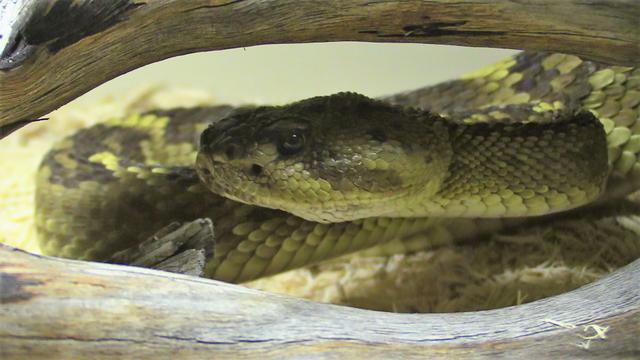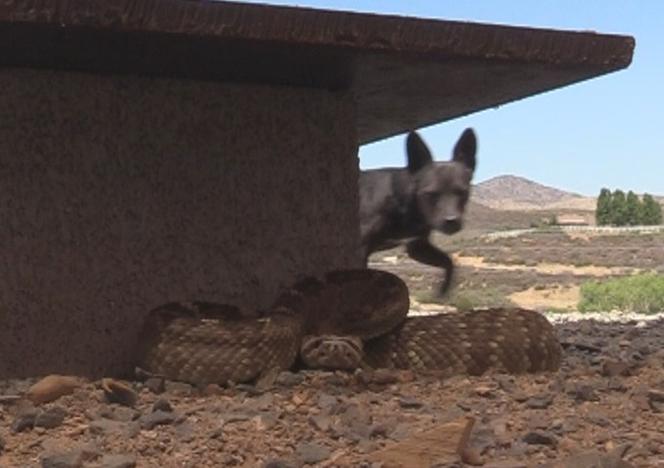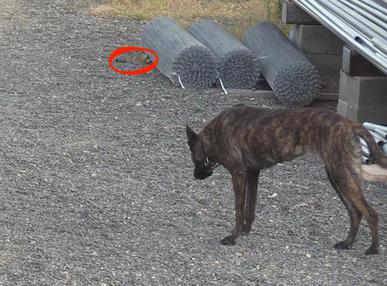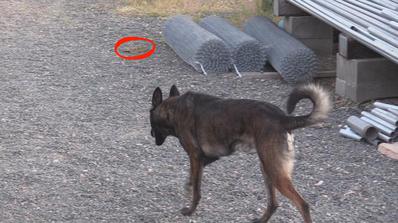Rattlesnake Avoidance
Rattlesnakes are very active towards the end of summer: On 9/14/2015 I was returning from a evening hike with three of my dogs Cloe, Jesse and Jax. As we approached the front door to my house there was the sound of a Rattlesnake. All three of my dogs stopped at a safe distance on their own and held position until I made the decision that we would go around and enter the house from the back yard. I grabbed some gear and a flash light and captured the Rattlesnake right outside the front door, adding another beautiful black-tailed Rattlesnake to my collection. Situations like this are not uncommon around my property and all of my dogs are well trained to keep safe distances and know how to navigate around snakes.
This weekend, 9/19/2015 I trained a cute little female Rottweiler that had been bitten by a Rattlesnake the first week of September 2015. While hiking a trail on Thumb Butte in Prescott AZ, the owners said their dog stuck her head in a bush. They heard a rattle. The dog did not react much, so the owners didn’t pay much attention until their dog's face started to swell. The trip to pet emergency cost $2500. They were all lucky the situation wasn’t worse.
During the Rattlesnake aversion training this same little Rottie fully engaged the muzzled Rattlesnake in a curious way, and didn’t take the rattlesnake's threat display seriously. Since this female Rottweiler is a sensitive dog I started at lower levels of stimulation and took my time training with lots of fun times between stations. By the end of the training she understood the danger and was navigating around the danger.
More videos and a few pictures.
2016 "Lottie" going through her first season of training.
This video will give you a good idea of what to expect from my rattlesnake aversion program.
2018 This video will give a good idea of what its like to live with dogs and the seasonal threat of rattlesnake encounters.
Bed & Biscuit requires a preliminary evaluation of your dog before rattlesnake training. This class gives me the opportunity to observe your dog’s temperament. Is your dog a highly driven hunter, sensitive, playful and curious or somewhere in between. It also determines if your dog is collar sensitive and we begin working on E-collar conditioning. This evaluation also gets your dog familiar with the environment before the rattlesnake aversion class. All training classes are private with a maximum of three dogs per class; we do not offer group classes, this way we can focus on the individual needs.
Jax and Lottie being tested to make sure they can detect and stay clear of rattlesnakes.
Routine feeding with with spicy and fang.
Call me if you'd like a personal tour of Bed & Biscuit. I'm usually busy caring for my guests so please call ahead to schedule an appointment.
Arizona has 13 species of rattlesnakes: In the Humboldt area, I have had encounters with Diamondbacks, Black-Tailed, Arizona Blacks and Mojave's. When threatened, most Rattlesnakes become defensive and would rather avoid confrontation. Rattlesnakes do not always give a warning even when provoked. Whether they warn us or not, it's prudent to avoid rattlesnakes and to teach our dogs to stay away from them, avoiding painful, damaging and potentially lethal snakebites.
Although some dogs instinctively avoid snakes, most dogs are very curious and have no idea of the potential danger. Many years ago my friend and I lost a very valuable stud dog to a Mojave Green. We heard a commotion outside in the back yard. When we went to investigate it was too late. Our dog had killed the Mohave but died from its bites 15 minutes later. He had been vaccinated with the rattlesnake vaccine, but the vaccine does not cover the Mojave's potent neurotoxic venom. Regardless of rattlesnake species or if the dog was vaccinated, an allergic reaction to the venom, multiple venomous bites or one bite in a vital area can overwhelm the dog's system causing shock and then death.
In the years after losing our dog, I started collecting rattlesnakes for study and developing a training program to teach dogs how to recognize and stay clear of them. I am now working with Arizona Game and Fish Department to develop a rattlesnake educational program for people and their dogs. 2024 State Permit wildlife holding educational; LIC# SP621813.
Rattlesnake-aversion training: Training takes place at my facility located on 22 acres of chaparral forest. The objective of this course is to teach your dog to identify and stay clear of snakes. During training, live muzzled rattlesnakes are used to simulate real situations.
Next we teach your dog how to keep safe distances, learn to navigate around the danger and minimize your dog’s confusion when encountering snakes. The objective is to keep the dog moving and focused on the task. This relaxes the dog so his senses are properly engaged, enabling him to react correctly in a real rattlesnake situation. Success is achieved when the dog's owner can safely recall their pet with a rattlesnake between them as an obstacle. The dog should go around the rattlesnake at a safe distance, showing appropriately conditioned response, as the dog returns to its owner. Everybody's safe!
Rattlesnake vaccine for dogs: Red Rock Biologics makes a vaccine that generates protective antibodies which function by neutralizing rattlesnake venom. The vaccine was developed to protect against Western Diamondback rattlesnake venom. Venom from many other snakes found throughout the US is similar, so the vaccine may vary in protection against other species. For Arizona this vaccine does not cover the Mojave or the Coral snake. The vaccine only reduces the effects of the venom, so snakebites should be treated as a medical emergency. Whether or not your dog has been vaccinated, you should get your dog to a vet as soon as possible. Snake-related factors include the snake species, age of the snake and amount of venom injected. Dog-related factors include size of dog, how their immune system reacts to snake venom, location of the bite, how well the dog responded to the vaccine and the length of time since the last booster was administered.
Aversion training: We start the aversion training by introducing your dog to a muzzled rattlesnake in one of my training fields with no other distractions around. As we get closer to the snake we allow your dog to find the snake on their own. When your dog is fully engaged on the snake, stimulation will be given to represent a bite from the snake. When this artificial bite is given, your dog will be guided away from the threat. Next we test your dog with different approaches depending on the type of dog you have. At this point stimulation will only be used if necessary. Once your dog is avoiding the snake, then we take a break to relax and reset your dog’s mind.
Next, we work on scent detection and sound recognition: I combine the scent and sound using rattlesnake skin shed and my invention a robotic rattlesnake tail. The skin and robotic tail are placed at strategic locations along the many trails in the training area, such that the scent funnels downwind. Usually at this point in the training the dog is familiar with the scent and will detect and stop at a safe distance. At this point I will activate the robotic tail and guide the dog to a safer distance. stimulation is rarely necessary. We do this several times along different trails until you and your dog are working as a team to detect the scent and recognize the sound of rattlesnakes. Then we will take another break.
Years ago, when I was developing my rattlesnake avoidance training program one of my concerns was, would using an E-Collar for the avoidance training adversely affect the dog for future E-Collar training on any measure. What I found was that as long as the dog was focused on the snake (sight, scent, sound) with NO other distractions on their mind, they thought the snake bit them when stim was given. Whether the dog has been previously trained with an E-Collar or their first time. The only time I have seen signs that the dog related stimulation to the E-Collar is when the dog had been exposed to an E-Collar in the past and it was used as a punishment device. But the signs are very clear when just the sight of a transmitter or collar makes them nervous.
This is why I have a preliminary meet and greet to get the dog used to me, the area and talk to the client about proper conditioning of E-Collars before the real training is scheduled. Then when the dog returns, it is familiar with the training environment and E-Collar which reduces the chance of unwanted associations and potential distractions.
All my classes are private (NO group setting) except for dogs that work together like SAR or family dogs. The use of an E-Collar for snake training is the only way to form a snake- threat conditioned memory that a dog will recall and respond to implicitly and explicitly. The dog reacting and making their own decisions will save their life from a Mojave, AZ Black or Diamondback.
The fast-food version of rattlesnake aversion training is to process as many clients as you can. A lot more money is made this way, but then a lot of very important things get left out and unwanted things, like distraction, sensitivities, and unwanted associations get incorporated into the training. Regardless of the downfalls of this fast-food version, one surprising fact I have found while testing these dogs (WITH NO E-COLLAR) is that about 80% pass the first part of the test (reacting and staying away from the snake) provided the snakes were muzzled and not in cages in which case the percentage drops to 20%. Percentages drop again on the second part of the test when the dog observes the movement of a snake. Then the dog`s hunting or prey drive kicks in overriding the threat conditioning. The dog goes right to the snake and fails the test.
There is more to the test, but I want to finish by addressing the public’s perception about the effects of stimulation associated with this type of training. I use the lowest levels of stimulation possible. But note that levels must be high enough to activate the dogs threat system. If the dog jumps, it’s more likely a reaction to the threat than the stimulation. For example, if you were in a haunted house feeling heightened awareness and someone tapped you on the shoulder, it would spook you and you would overreact to a perceived threat.




